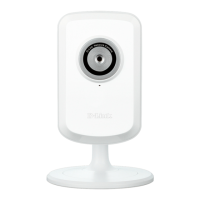







Do you have a question about the D-Link DCS-930L and is the answer not in the manual?
| Maximum resolution | 640 x 480 pixels |
|---|---|
| White balance | Auto |
| Minimum illumination | 1 lx |
| Sensor type | CMOS |
| Optical sensor size | 1/5 \ |
| Digital zoom | 4 x |
| Security algorithms | WEP, WPA, WPA2 |
| Video motion detection | Yes |
| Cabling technology | 10/100Base-T(X) |
| Supported network protocols | IPV4, ARP, TCP, UDP, ICMP, DHCP, NTP, DNS, DONS, SMTP, FTP, HTTP, PPPoE, UPnP, LLTD |
| AC input voltage | 100-240 V |
| DC output current | 1.2 A |
| DC output voltage | +5V |
| AC input frequency | 50 - 60 Hz |
| Power over Ethernet (PoE) | - |
| Power consumption (typical) | 2 W |
| Ethernet LAN (RJ-45) ports | 1 |
| Certification | FCC B, IC, C-Tick, CE |
| Placement supported | Indoor |
| Dimensions (WxDxH) | 27.2 x 60 x 96 mm |
| Compatible operating systems | Windows XP / Vista / 7 |
| Flash memory | 4 MB |
| Internal memory | 32 MB |
| Storage temperature (T-T) | -20 - 70 °C |
| Operating temperature (T-T) | 0 - 40 °C |
| Operating relative humidity (H-H) | 20 - 80 % |
| Form factor | Cube |
| Weight | 76.9 g |
|---|
Details manual version history and dates.
Lists trademarks and copyright information for D-Link products.
Provides essential safety guidelines to ensure user and product safety during operation.
Highlights critical safety warnings, including strangulation hazards and small parts.
Lists all items included in the DCS-930L product package.
Details the system, software, and network prerequisites for using the camera.
Describes the key functionalities and capabilities of the DCS-930L camera.
Illustrates and labels the physical components on the front and rear of the camera.
Explains the easy setup process using a D-Link Cloud Router and mydlink account.
Guides users through setting up the camera without a Cloud Router using a wizard.
Provides steps for manually installing the camera's hardware and basic configuration.
Details how to establish a wireless connection using Wi-Fi Protected Setup (WPS).
Provides step-by-step instructions for physically mounting the camera on a wall or ceiling.
Explains the mydlink service for remote viewing and management of cameras.
Lists and describes the available mobile applications for accessing mydlink services.
Instructions on how to log into and use the camera's web-based configuration interface.
Describes how to view the real-time video stream from the camera.
Step-by-step guide to configure the camera's network and internet settings.
Detailed options for configuring LAN, IP, and port settings for network connectivity.
Guides on configuring the camera's wireless network name, channel, and security.
Options for adjusting image quality, video resolution, and display settings.
Setup for motion and sound detection to trigger alerts.
Configuration for sending email alerts and uploading snapshots to FTP.
Managing administrator password, firmware upgrades, and system settings.
Displays comprehensive network connection details and current camera status.
Steps to assign a static IP address to the camera for network recognition.
How to access and view the camera's live feed using a web browser on the LAN.
Guides on accessing router settings and configuring virtual server ports for remote access.
Explains the different wireless security options: WEP and WPA-PSK.
Details on Wired Equivalent Privacy (WEP) encryption and its key requirements.
Explanation of Wi-Fi Protected Access (WPA/WPA2) security features.
Solutions for problems preventing remote camera access.
Diagnosing issues related to LED indicators and unreliable network connectivity.
Instructions on how to reset the camera's password if forgotten.
Troubleshooting steps for poor, noisy, or artifacted images and browser display problems.
Introduces fundamental concepts of wireless networking and D-Link's role.
Describes the benefits and applications of wireless technology for home and office users.
Defines and differentiates between Infrastructure and Ad-Hoc wireless networking modes.
Steps to verify the camera's IP address using command prompt on Windows.
Procedure for manually assigning a static IP address to the camera.
Lists the necessary hardware, operating system, and software for the camera.
Details supported networking protocols and wireless connectivity standards.
Specifications for image control, power, dimensions, temperature, and certifications.
Contact details and preparation guidelines for D-Link technical support.
Outlines the hardware and software warranty period, coverage, and limitations.
Instructions for submitting warranty claims in the USA and Canada.
Details FCC, CE, and Industry Canada compliance and safety statements.
Information and link for registering the product online.